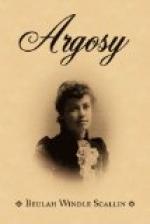The church of Guimiliau dates chiefly from the sixteenth century. The aisles and the south porch are Renaissance, richly ornamented by delicate sculptures representing scenes from the Old and New Testament; statues of the Apostles. The triumphal arch and ossuary are very inferior to St. Thegonnec, but the calvary is a magnificent monument, unequalled in Brittany, richly sculptured and ornamented. It rests on five arches, and you ascend to the platform by a short staircase in the interior. Here are crosses bearing the Saviour, and the thieves, quaintly carved, but with a great deal of religious feeling. The Evangelists, each with his particular attribute portrayed, are placed at the angles: and the whole history of the Life of Christ is represented by a countless number of small figures or personages dressed in costumes of the sixteenth century. The effect is occasionally grotesque, but very wonderful. A procession armed with drums and other instruments precedes the Bearing of the Cross; and another scene which does not belong to the Divine Life, but was introduced as an accessory, represents Catel Gollet (the lost Catherine) precipitated by devils in the form of grotesques into the jaws of a fiery dragon emblematical of Purgatory.
Catel Gollet was one who concealed a sin in confession, was condemned to suffer, and returning miraculously in 1560 announced her condemnation to her companions in these terms:
Voici ma main, cause de mon
malheur,
Et voici ma langue detestable!
Ma main qui a fait le peche,
Et ma langue qui l’a
nie.
The bas-relief represents the Adoration of the Magi, and bears date 1588, whilst the upper part bears that of 1581.
The interior of the church possesses some wonderful and almost matchless carved wood, which surprised and delighted us. There were sixteenth century statues, full of expression, of St. Herve and St. Miliau; an elaborate and beautiful pulpit, a font with a canopy supported by twisted columns, magnificently carved and thirty feet high, dated 1675; a matchless organ case, with three bas-reliefs, representing David, St. Cecilia and a Triumphal March, the latter reproduced from one of Alexander’s battles by Lebrun.
In short, Guimiliau was a treasury of sculptured wood, which alone would have made it remarkable amongst churches. It was almost impossible to leave its fascination, and I fear that we more than envied the church its possession. It also came with a surprise, for we had heard nothing of this treasure of refined carving, and had anticipated nothing more than the wonderful calvary. It still lives in our imagination, almost as a dream; a dream of beauty and genius.
We lingered as long as we dared, but knew that we should not travel back at express speed, and that our coachman, after his indulgence in Breton beer or spirit, would probably be more sleepy than ever.
The sun was declining as we left Guimiliau, the church and its monuments forming a very singular composition against the background of the sky as we turned and gave it a farewell look. One scarcely analysed the reason, but there was almost an effect of heathendom about it, as if it dated from some remote age, when visible objects were worshipped, and the sun and the moon and dragons and grotesques took a prominent place in religion.




